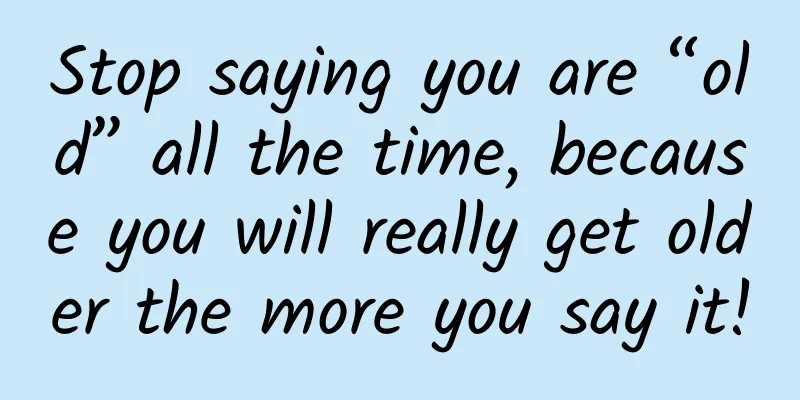Attention! These 9 lifestyle habits are quietly "stealing" the calcium in your body!

|
I am very familiar with calcium supplementation. I have been taking it since I was a child, drinking milk, bone soup, taking calcium supplements... everything. However, you may have taken calcium supplements in vain. Beware of these "calcium thieves" who quietly make "children grow short, adults have fragile bones, and middle-aged and elderly people more susceptible to osteoporosis." Let's find out these "thieves" one by one today. Thief No. 1 Love strong tea and coffee Coffee is a good helper for most urban beauties to "extend their lives", but coffee contains a lot of caffeine, which can increase the excretion of calcium due to its diuretic effect. If consumed in excess, it will increase the risk of osteoporosis. Similarly, strong tea, dark chocolate, etc. also contain caffeine. Image source: Wikipedia, Photo: Haneburger Prevention tips: 1. Coffee lovers, don’t panic. A healthy adult should consume no more than 210-400 mg of caffeine per day, which is roughly equivalent to two large cups of Starbucks. [1] It is recommended to add more milk when drinking coffee. It is better to “replenish while losing” than to “lose all the time”. 2. As for tea, you can drink some light tea. Tea contains tea polyphenols and other ingredients that are beneficial to health. After being soaked in water, they can be dissolved in tea. If you are already on a low-calcium diet or have osteoporosis, it is recommended to drink less strong tea and coffee. Thief No. 2 Eating too salty The salty taste of table salt comes from its ingredient sodium chloride. Sodium has the characteristic of "the more you eat, the more you excrete" in the body. You should know that more than 98% of the sodium you consume is excreted in the urine. Unfortunately, the metabolism of sodium will increase the loss of calcium. And the calcium lost in urine is about half of the calcium retained in the body. Therefore, eating too much salt has a great impact on bone loss. A high-sodium diet is one of the main risk factors for osteoporosis. It is true that "too much salt" will lead to loss. For every 2,300 mg of sodium consumed, 24 to 40 mg of calcium is taken away. [2] However, the average daily sodium intake of the general population is 6,046 mg, which takes away 2.6 times as much calcium. Prevention tips: 1. Daily salt intake should be controlled below 5g, which is equivalent to a beer bottle cap. (1 gram of salt = 400 mg of sodium) 2. Be wary of the presence of hidden salt. Foods like soy sauce, chicken essence, MSG, oyster sauce, bean paste, and fermented bean curd all have high salt content. Thief No. 3 Excessive drinking Excessive drinking not only affects the absorption of vitamin D and calcium, but also directly affects osteoblasts, inhibiting bone formation[3]. In other words, the amount of bone destroyed is greater than the amount of bone formed, bone loss begins, and bones will prematurely fall into a state of "expenditure exceeding income". The more alcohol you drink, the more brittle your bones become, and the more likely you are to develop osteoporosis. Prevention tips: 1. If you drink alcohol, you should limit the amount you drink. This means that if you don’t drink alcohol, there is no need to learn to drink alcohol. Drinking alcohol has no benefits at all. If you have the habit of drinking, you must strictly limit the amount you drink. 2. Limit how much you drink. The Dietary Guidelines for Chinese Residents (2022 Edition) recommends that adults should not drink more than 15 grams of alcohol a day. This is roughly equivalent to 450 ml of beer, 150 ml of wine, and 50 ml of 38-proof liquor. You can also divide 1500 by the alcohol content, and the number of milliliters you get is the maximum amount you can drink in a day. It should also be noted that the recommended amount is the maximum amount of alcohol consumed, not the recommended amount. Thief No. 4 Smoking Smoking causes increased bone loss and reduced intestinal calcium absorption. Meta-analysis shows that smokers have lower bone density than non-smokers. [4] Osteoporosis caused by reduced bone density increases the risk of fractures, so smoking cessation is recommended. Are mainstream e-cigarettes safe? E-cigarettes are actually cigarettes. The main ingredients of most e-cigarette liquids are nicotine, propylene glycol, glycerin, etc. Although the nicotine content in e-cigarettes can be adjusted, the nicotine contained cannot be underestimated. Nicotine can affect the normal physiological functions of osteoblasts and osteoclasts. In short, e-cigarettes also have a great negative impact on bone health, and the use of e-cigarettes can also lead to decreased cognitive ability. [5] Image source: Pixabay Prevention tips: Whether it is traditional cigarettes or e-cigarettes, whether it is teenagers or adults, they should stay away from them. Also pay attention to second-hand smoke and third-hand smoke, which are still harmful to the body. Thief No. 5 Sun protection is too good Hiding from the sun We know that there is really little vitamin D from food sources, and people mainly obtain it through natural means such as sunbathing. Sunbathing can promote the synthesis of vitamin D, and vitamin D can promote calcium absorption. Calcium and vitamin D are a golden pair, and neither is perfect without the other. However, people now have a strong awareness of "love of beauty". Due to environmental pollution, seasons, regions and other reasons, people either do too much sun protection or cannot get sunlight. In this case, the body is very prone to vitamin D deficiency. Prevention tips: 1. If you have the conditions to sunbathe, it is recommended to expose your face and arms to sunlight for 15 to 30 minutes every day, which can meet the needs of synthesis. However, you should pay attention to choosing a time period with milder sunlight (which may be adjusted according to the season, region, latitude, etc.) and avoid strong sunlight to prevent skin burns. [6] 2. Vitamin D supplements: 400 IU per day for those under 65 and 600 IU per day for those over 65. [7] When used to prevent and treat osteoporosis, the dose can be increased to 800-1200 IU, and the maximum tolerable intake is 2000 IU. [6] Thief No. 6 Lack of exercise, too little exercise Numerous studies have shown that physical activity and exercise training have a protective effect on bone health. Exercise can stimulate bone formation and metabolism, and can also slow down bone loss. Both aerobic and resistance exercise have a positive effect on increasing bone density. [8,9] People who do not like or lack exercise have a higher risk of osteoporosis than those who love exercise. [10] Prevention tips: 1. Perform at least 150 minutes of moderate-intensity physical activity per week, until you feel slightly sweaty and a little tired, but can still talk normally. You can increase your aerobic exercise time by walking briskly, mopping the floor, dancing, etc. 2. It would be better if you can add resistance exercise 2-3 days a week. We can use water bottles, dumbbells, elastic bands to exercise. In addition, push-ups and pull-ups are also good resistance exercises. In other words: aerobic exercise every day, resistance exercise is indispensable. Remember to warm up before exercise and stretch after exercise. Thief No.7 Improper diet and dieting Preferring a more extreme high-protein, low-carb diet/meat-eating diet will increase the blood ketone body level, thereby increasing bone calcium loss. In addition, dieting and picky eating may lead to insufficient calcium intake from food, which will also reduce the digestion and absorption capacity. In the long run, it is easy to cause malnutrition, which is a risk factor for low bone density. Prevention tips: A balanced diet can protect our own health, so it is recommended to have a balanced diet. Weight loss should be done in a gradual manner. In special circumstances, it is recommended to do it under the guidance of a physician or professional nutritionist. Thief No. 8 Excessive intake of beverages Common beverages/drinks include carbonated drinks, fruit and vegetable juices and their drinks, protein drinks, etc. [11], which contain sugar and sodium, which will increase calcium loss. In addition, the phosphoric acid contained in carbonated beverages can also affect calcium absorption. However, this is based on the premise that the individual's daily calcium intake is low or insufficient. In this case, consuming high-phosphorus beverages will interfere with calcium absorption and inhibit the activation of 25(OH)D3, reducing the production of 1,25(OH)2D3, and ultimately affecting bone metabolism. [2] The biggest sin of carbonated drinks is actually the high sugar content. For example, the cola soda in the picture below contains more than 10% sugar. If you gulp down 300 ml of it, you will consume 32 grams of sugar, which is equivalent to 7 sugar cubes. Too much sugar is not good for preventing tooth decay, obesity, and osteoporosis. Image source: Photographed by the author Prevention tips: Drink less sugary drinks on a daily basis. It is recommended that the daily intake of added sugar should not exceed 50 grams, and it is best to control it below 25 grams. Thief No.9 Superstitious about fake calcium foods Many people are very aware of calcium supplementation, but they choose the wrong foods. For example, these foods do not supplement calcium: The calcium content in soy milk is less than 1/10 of that in milk, so it is not reliable. Eating meat does not supplement calcium. A moderate amount of protein helps calcium absorption, but too much is not conducive to calcium absorption. Bone soup does not supplement calcium. The thick white content is not calcium but fat. It does not supplement calcium but instead makes you fat. It is true that eating tofu can supplement calcium, but tofu pudding, rennet tofu, Japanese tofu, and yuba cannot. The calcium content of dried shrimp is nearly 10 times that of milk. You can only add a few grams of it when cooking or making soup. It is not easy to chew and has a high sodium content. If you don’t get enough calcium, you may choke. Prevention tips: Correct calcium supplement foods: soy products, with northern tofu, southern tofu, dried tofu, tofu skin, etc. being the first choices. Choose the right calcium-supplementing foods, eat a balanced diet, stay away from sweets and sweet drinks, don't eat too salty food, don't diet or lose weight randomly, quit smoking and limit alcohol, exercise regularly, and get some sun if conditions allow. You can also supplement with calcium and vitamin D preparations. Make sure to supplement calcium in the right way, increase revenue and reduce expenditure, don’t let calcium slip away, and ensure that calcium is truly absorbed by the bones without causing any "mines" to bone health. I wish you all: sufficient bones and calcium, and a healthy life. References [1] Scientific consensus on coffee and health [2] Yang Yuexin, Ge Keyou. Chinese Nutrition Science Encyclopedia 2nd Edition (Volume 1) [M]. People's Medical Publishing House, 2019: 103, 112, 121. [3] Du Xueping, Sun Yange, Guo Aimin, et al. Standardized community management program for primary osteoporosis[J]. Chinese General Practice, 2019, 22(11): 1251-1257. [4] Huang Qing, Chen Chengzhi, Zhang Zunzhen. Meta-analysis of the correlation between smoking and bone mineral density among Chinese adults[J]. Modern Preventive Medicine, 2016, 43(03): 475-481. [5] Liang Zhisheng, Zhang Zhenyu. Study on the relationship between e-cigarette use and subjective cognitive decline: Based on the 2016-2021 American Behavioral Risk Factor Surveillance Survey [J/OL]. Shanghai Preventive Medicine: 1-9 [2023-10-30]. http://kns.cnki.net/kcms/detail/31.1635.R.20230823.1328.016.html. [6] Expert consensus on the diagnosis and treatment of osteoporosis in primary care institutions (2021) [7] “Dietary Reference Intakes for Chinese Residents (2023 Edition)” [8] Zheng Ze. Study on the effect of continuous aerobic exercise training on children's bone density and muscle strength development[J]. Stationery and Sports Goods and Technology, 2023(17):157-159. [9] Chinese Nutrition Society. Dietary Guidelines for Chinese Residents (2022)[M]. People's Medical Publishing House, 2022: 42-43. [10] Weaver CM. Calcium requirements of physically active people. Am J Clin Nutr. 2000 Aug;72(2 Suppl):579S-84S. [11] GB 7101-2022 National Food Safety Standard Beverages Author: Wang Yanli, Chinese registered nutritionist Review丨Ruan Guangfeng, Deputy Director of Kexin Food and Health Information Exchange Center |
<<: Interpretation of winter health preservation concepts in Huangdi Neijing
>>: Popular knowledge about unprotected perineal delivery techniques
Recommend
Why can't skim milk be used to make yogurt? What is the difference between whole milk powder and skim milk powder?
Skim milk is a dairy product that has some fat re...
Reasons for delayed menstruation and low menstrual volume
Many women experience this situation: the menstru...
5 things to know about endometrial cancer surgery!
Author: Zhang Jingfei, deputy chief physician, Be...
What causes abdominal pain after menstruation?
It is very important for women to take care of th...
Can I keep the baby if I do CT during pregnancy?
Many women will try to keep fit during pregnancy ...
How to relieve stomach acid in early pregnancy
Nowadays, people will experience some discomfort ...
Are Apple's retail stores in mainland China closed? Why is Apple closing its retail stores in mainland China?
When it comes to mobile phones, the first thing t...
How to make sweet and sour spareribs soft and tender (the ribs should be drained and boiled again)
...
What are the treatments for increased premenstrual leucorrhea?
Increased vaginal discharge is a very common dise...
What are the 5 signs of a woman's kidney failure?
The kidneys are very important detoxification org...
Infant heat syndrome: the hidden threat behind warmth
This is the 5251th article of Da Yi Xiao Hu As th...
How to make your breasts smaller quickly
Students with big breasts sometimes feel very emb...
Things you may not know about voluntary blood donation | Why do you need to have a routine blood test before seeing a doctor?
When a child has a fever, cough, or sore throat, ...
8 weeks pregnant belly bulge
We all know that after a woman becomes pregnant, ...
Are boys or girls more likely to have leaky tires?
Abortion refers to a small amount of vaginal blee...









